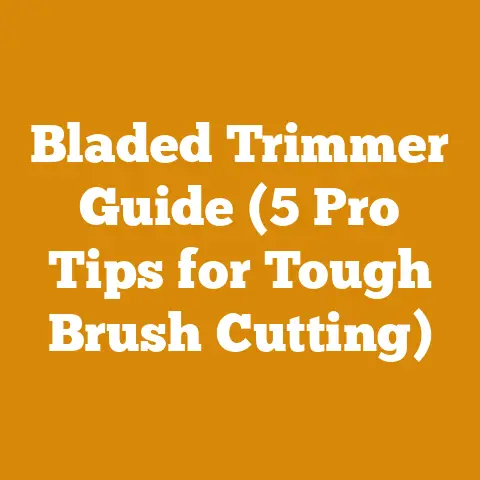Stihl Bulk Chain Compatibility (5 Pro Tips for Bar & Sprocket Match)
Imagine this: you’re deep in the woods, felling a massive oak with your trusty Stihl chainsaw.
The air is thick with sawdust, the smell of fresh-cut wood intoxicating.
You’re making great progress, but then disaster strikes – your chain breaks!
You reach for your spare, only to realize it’s the wrong size.
A frustrating and potentially costly mistake, right?
I’ve been there, and that’s why understanding Stihl bulk chain compatibility is crucial.
Over the years, I’ve learned the hard way that matching the right chain to your bar and sprocket isn’t just about convenience; it’s about safety, efficiency, and the longevity of your equipment.
Stihl Bulk Chain Compatibility: 5 Pro Tips for Bar & Sprocket Match
In this guide, I’ll share my top five pro tips for ensuring you get the perfect match every time.
We’ll delve into the intricacies of chain pitch, gauge, drive link count, and how they interact with your bar and sprocket.
We’ll also cover the importance of proper maintenance and troubleshooting common compatibility issues.
So, grab your chainsaw, and let’s get started!
1. Understanding the Basics: Pitch, Gauge, and Drive Links
Before we dive into specific Stihl models, let’s establish a solid understanding of the fundamental chain characteristics: pitch, gauge, and drive link count.
These three parameters are the cornerstones of chain compatibility.
Pitch: This is the distance between any three consecutive rivets on the chain, divided by two.
It’s usually measured in inches.
Common Stihl chain pitches include .325″, 3/8″ (0.375″), and .404″.
I’ve found that using a pitch gauge tool can be incredibly helpful for accurate measurement, especially when dealing with older or worn chains.Gauge: The gauge refers to the thickness of the drive links – the part of the chain that fits into the groove of the guide bar.
It’s also measured in inches or millimeters.
Common Stihl chain gauges include .043″ (1.1mm), .050″ (1.3mm), .058″ (1.5mm), and .063″ (1.6mm).
Using the correct gauge is crucial for a proper fit and prevents the chain from binding or rattling on the bar.Drive Link Count: This is simply the number of drive links in the chain.
It’s directly related to the length of the guide bar.
A longer bar requires more drive links.
Counting the drive links is essential when buying a bulk chain and cutting it to the required length.
Why are these important? A mismatch in any of these parameters can lead to poor cutting performance, increased wear and tear on your equipment, and even dangerous situations like chain breakage or kickback.
Personal Experience: I once tried to use a .325″ pitch chain on a bar designed for 3/8″ pitch.
The chain didn’t sit properly on the sprocket, causing excessive vibration and a severely reduced cutting speed.
It was a frustrating and ultimately wasteful experience.
Takeaway: Always identify the pitch, gauge, and required drive link count for your specific Stihl chainsaw, bar, and sprocket combination before purchasing a bulk chain.
2. Identifying Your Stihl Chainsaw Model and Bar Specifications
The first step in ensuring compatibility is to accurately identify your Stihl chainsaw model.
This information is usually found on a sticker or plate located on the saw’s body, often near the engine or handle.
Once you have the model number, you can consult your owner’s manual or the Stihl website to determine the recommended chain specifications.
Finding the Right Bar: The guide bar also has specific requirements.
The length of the bar is usually stamped on the bar itself, along with other identifying marks.
You’ll also need to know the bar’s groove width (which corresponds to the chain gauge) and the sprocket type (more on that later).
Example: Let’s say you own a Stihl MS 271 Farm Boss.
According to the Stihl website, this model typically uses a .325″ pitch chain with a .063″ gauge.
The recommended bar length can vary, but let’s assume you have an 18″ bar.
A quick search reveals that an 18″ bar for the MS 271 typically requires 74 drive links.
Pro Tip: If you’ve lost your owner’s manual, you can usually find a digital version on the Stihl website or by contacting their customer support.
Case Study: I once helped a friend who was struggling to find the right chain for his vintage Stihl 041 Farm Boss.
He had inherited the saw and didn’t have the original manual.
By carefully measuring the pitch and gauge of the old chain (using a pitch gauge and calipers) and counting the drive links, we were able to determine the correct specifications and order a compatible chain.
Takeaway: Always confirm your chainsaw model and bar specifications before ordering a bulk chain.
Consult your owner’s manual or the Stihl website for accurate information.
3. Sprocket Selection: Rim vs. Spur
The sprocket is the toothed wheel that drives the chain around the bar.
Stihl chainsaws typically use one of two types of sprockets: rim sprockets and spur sprockets.
Understanding the difference between these is crucial for ensuring proper chain engagement and preventing premature wear.
Rim Sprockets: These consist of a replaceable sprocket rim that sits on a splined hub.
The rim is designed to be easily replaced when worn, which is more economical than replacing the entire sprocket assembly.
Rim sprockets are generally preferred for their smoother operation and reduced vibration.
I’ve found that they also tend to be more forgiving with slight variations in chain pitch.Spur Sprockets: These are one-piece sprockets where the teeth are directly attached to the hub.
Spur sprockets are typically found on older or less expensive chainsaws.
They are less expensive to manufacture but tend to wear out faster and can be more prone to vibration.
Compatibility Considerations: It’s essential to use the correct type of chain for your sprocket.
While some chains are compatible with both rim and spur sprockets, others are specifically designed for one type or the other.
Using the wrong chain can lead to poor performance and accelerated wear.
Upgrade Potential: If you have a chainsaw with a spur sprocket, you might consider upgrading to a rim sprocket.
This can improve the saw’s performance and reduce vibration.
However, make sure the rim sprocket is compatible with your chainsaw model and bar.
My Experience: I upgraded my old Stihl 028 Super from a spur sprocket to a rim sprocket, and the difference was immediately noticeable.
The saw ran smoother, vibrated less, and the chain seemed to stay sharper for longer.
Takeaway: Identify the type of sprocket on your Stihl chainsaw and choose a chain that is compatible with it.
Consider upgrading to a rim sprocket for improved performance and reduced vibration.
4. Bulk Chain Selection and Preparation: Cutting and Joining
Once you’ve determined the correct pitch, gauge, and drive link count for your chainsaw, you can purchase a bulk chain.
Bulk chains are typically sold in 25-foot or 100-foot rolls, allowing you to cut and assemble chains to the exact length you need.
This is often more economical than buying pre-made chains, especially if you own multiple chainsaws or frequently replace your chains.
Essential Tools: To work with bulk chains, you’ll need a few essential tools:
Chain Breaker: This tool is used to separate the chain at a specific link.
I recommend investing in a high-quality chain breaker for clean and precise cuts.Chain Spinner/Rivet Spinner: This tool is used to rivet the chain back together after adding or removing links.
A good rivet spinner will ensure a strong and durable connection.Chain Joiner Links (Tie Straps): These are special links used to connect the two ends of the chain.
Make sure you use the correct tie straps for your chain’s pitch and gauge.File Guide and Files: These are essential for sharpening the cutters on the chain.
A properly sharpened chain will cut faster and more efficiently.
Cutting the Chain: Use the chain breaker to separate the chain at the desired number of drive links.
Count carefully to ensure you have the correct length.
It’s always better to err on the side of being slightly too long, as you can always remove additional links.
Joining the Chain: Insert the tie strap into the two ends of the chain.
Use the rivet spinner to carefully rivet the tie strap in place.
Make sure the rivets are properly seated and that the chain moves freely.
Safety First: Always wear safety glasses when working with chains and rivets.
Small pieces of metal can fly off during the cutting and riveting process.
Troubleshooting: If you find that the chain is too tight or too loose after joining, you may need to add or remove a drive link.
Use the chain breaker to separate the chain, adjust the length, and then re-join it.
Takeaway: Invest in quality chain breaking and riveting tools.
Carefully count the drive links before cutting the chain.
Always wear safety glasses.
5. Troubleshooting Compatibility Issues and Maintenance Tips
Even with careful planning, you might encounter compatibility issues.
Here are some common problems and how to address them:
Chain Binding: If the chain is binding on the bar, it could be due to several factors:
- Incorrect Gauge: The chain gauge might be too large for the bar groove.
Double-check the specifications and ensure you’re using the correct gauge. - Damaged Bar: The bar groove might be damaged or worn.
Inspect the bar for burrs or uneven wear and repair or replace it as needed. - Insufficient Lubrication: The chain might not be receiving enough oil.
Check the oiler system and ensure it’s functioning properly.
- Incorrect Gauge: The chain gauge might be too large for the bar groove.
Chain Slipping: If the chain is slipping on the sprocket, it could be due to:
- Worn Sprocket: The sprocket teeth might be worn or damaged.
Replace the sprocket if necessary. - Incorrect Pitch: The chain pitch might not match the sprocket pitch.
Double-check the specifications and ensure you’re using the correct pitch. - Loose Chain: The chain might be too loose.
Adjust the chain tension according to the manufacturer’s instructions.
- Worn Sprocket: The sprocket teeth might be worn or damaged.
Premature Chain Wear: If the chain is wearing out quickly, it could be due to:
- Improper Sharpening: The chain might not be sharpened correctly.
Use a file guide and files to sharpen the cutters to the correct angles. - Lack of Lubrication: The chain might not be receiving enough oil.
Check the oiler system and ensure it’s functioning properly. - Abrasive Conditions: Cutting in dirty or sandy conditions can accelerate chain wear.
Clean the chain and bar frequently.
- Improper Sharpening: The chain might not be sharpened correctly.
Maintenance Tips:
- Sharpen Regularly: Keep your chain sharp by filing the cutters regularly.
A sharp chain will cut faster, more efficiently, and with less effort. - Lubricate Properly: Ensure the chain is receiving adequate lubrication.
Check the oil level frequently and adjust the oiler system as needed. - Clean Regularly: Clean the chain and bar after each use to remove sawdust and debris.
- Inspect Regularly: Inspect the chain and bar for damage or wear.
Replace worn or damaged parts promptly. - Store Properly: Store your chainsaw and chains in a dry and clean place.
Metric for Success: A well-maintained chain, properly matched to the bar and sprocket, should last for several months of regular use.
I typically replace my chains after approximately 50 hours of cutting time, depending on the type of wood I’m cutting and the conditions I’m working in.
Real-World Example: I once had a client who was experiencing excessive chain breakage.
After inspecting his equipment, I discovered that he was using the wrong type of chain oil.
The oil was too thick and wasn’t properly lubricating the chain, leading to increased friction and premature wear.
Switching to a lighter, higher-quality chain oil solved the problem.
Takeaway: Regularly inspect and maintain your chainsaw and chains.
Address compatibility issues promptly to prevent further damage.
Bonus Tip: Consider keeping a logbook of your chain usage, including the date of purchase, hours of use, and any maintenance performed.
This will help you track the lifespan of your chains and identify any potential problems early on.
By following these five pro tips, you can ensure that you always have the right chain for your Stihl chainsaw.
This will not only improve your cutting performance but also extend the life of your equipment and enhance your safety.
Remember, a well-maintained chainsaw is a valuable tool that can provide years of reliable service.
So, take the time to understand your equipment and invest in the right parts and accessories.
Happy cutting!






